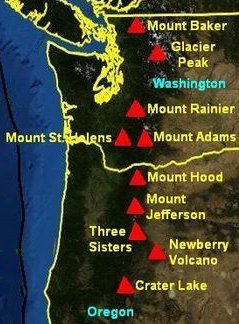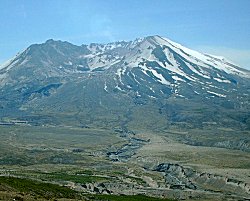Mount St Helens is best known for the violent eruption of that volcano in May, 1980 - the deadliest and most economically destructive volcanic event in the history of the United States.
Mount St Helens is part of the Cascade Volcanic Arc. This arc is itself part of the volcanically active zone spanning the Pacific which is known as the "Ring of Fire". Compared with the other major volcanoes of the Cascade Mountain Range (for example Mount Rainier) Mount St. Helens is relatively young.Formed within the last 40,000 years, it has been the most active in the Cascades for the last 10,000 year or so.

Geologists have been mystified by the actual location of the volcano, since Mt St Helens does not align with the other volcanoes along the Cascade Arc. Here magma, generated via flux melting in the mantle wedge migrates through the crust and erupts. But Mount St. Helens sits to the west of this line, making it an odd outlier.
Adam Schultz, a geophysicist from Oregon State University and his colleagues think that they solved the mystery. And it all comes down to plate tectonics. "Similar to the present day, where the Juan de Fuca plate is being subducted beneath North America, in the past crustal blocks with marine sediments were slammed into the continent, where they accreted...This material is more permeable than surrounding rock and allows the magma to move through it. The big batholith acts kind of like a plug in the crust and diverted magma that normally would have erupted in line with the other major Cascade volcanoes, resulting in St. Helens forming to the west of the Cascadia Arc, and Mt. Adams slightly to the east." Adam Schultz explains.
The crustal block he refers to is the Spirit Lake batholith, a subsurface rock formation some 32-48 km (20-30 miles) in diameter.
In this latest research (recently published in Nature Geoscience (ref)), Schultz and his co-authors adapted a technique originally used by the scientists from New Zealand's University of Canterbury in 2006, known as 'magnetotelluric technology'. This is an electromagnetic surveying method which maps subsurface resistivity (the measure of how strongly a material opposes the flow of an electric current). Variations are measured by naturally occurring electric and magnetic fields on the seabed or the Earth's surface.
Using this technique, the geologists collected images showing a broad lower-crustal mush zone containing interconnected melt. This underlies the segment of the arc where Mount St Helens should have developed. But instead the Spirit Lake batholith has channelled melt around itself to feed the volcano. The scientists believe that the images are clear enough that, by continuously monitoring the geoelectric and geomagnetic fields, they may be able to detect changes in the movement of magma beneath Mount St. Helens before the phase of dome-building begins.
As for Spirit Lake, this was originally formed about 4,000 years ago when valleys of the North Fork Toutle River and a tributary were blocked by lahars from a previous eruption of Mount St Helens. (A lahar is a violent type of mudflow or debris flow composed of a slurry of pyroclastic material, rocks and water. The material flows down from a volcano, typically along a river valley.)
During the 1980 eruption Spirit Lake was hit hard. The blast and the debris following the eruption displaced much of the lake from its bed creating waves up to 850 ft (260 m) above lake level, slamming the water into the mountain slopes on the north shore of the lake. Toxic gases destroyed all the oxygen and at the time scientists believed the lake would be very slow to recover. But just three years later life returned, first in the form of phytoplankton which began to restore the oxygen levels. Soon after frogs and salamanders appeared and the fish reintroduced to the lake is thriving.
Journal Reference:
https://www.nature.com/articles/s41561-018-0217-2
